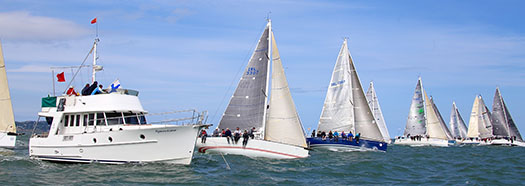#dlregatta – George Sisk's Farr 42 'Wow' that was crowned ICRA Division Zero champion last month has won the opening coastal race of Volvo Dun Laoghaire Regatta this afternoon. The Royal Irish entry took the lead in the impressive 25 boat IRC offshore division in choppy seas and 20–knot winds. Second was the canting keel Cookson 50 Lee Overlay Partners skippered by Adrian Lee. Third was another east coast boat, the J122 Aquelina skippered by James Tyrrell of Arklow.
Among the fleets participating, Howth Yacht Club's Storm skippered by Pat Kelly took an early lead in the J109 National Championships being sailed as part of the 2015 regatta.
The Howth entry made the most of a strong sea breeze gusting to 20 knots that delivered championship conditions and got all 29 classes off to a prompt start on Dublin Bay.
3000 sailors are racing in the four day regatta, the biggest sailing event in Ireland this year. Last night no less than 17 protests were heard. There were a number of collisions and a number of rescues inlcuding one for a crew with a reported dislocated shoulder.
Second in the 11–boat J109 fleet was the National Yacht Club's Something Else skippered by John Hall with third place going to recently crowned Irish Cruiser (ICRA) Division One champion, Joker II (John Maybury).
Conditions could not have been more different than the first race this time two years ago when light winds frustrated sailors in the biennial event.
Pat Kelly's Storm has taken an early lead in the J109 National Championships and (below) neck and neck with Joker II with only yards to a hectic drop-gybe-round leeward mark


Wildwood, a 2014 Round Ireland Race competitor, sailed by Ian Patterson of East Antrim is racing in the 25-boat IRC coastal class
Today was equally as testing but for completely different reasons as sailors dealt with choppy seas and gusty conditions that led to a number of collisions and gear damage.
Racing is being staged until Sunday over five separate courses for a combined fleet of 415 boats, with over 180 visiting yachts from 69 yacht clubs.
An impressive line up of eight class zero boats has made Volvo Dun Laoghaire regatta one of the biggest turnout this year for the near 40–footers. What's even more impressive is the fleet has been drawn entirely from outside the Bay. First blood has gone to Conor Phelan's Ker 37 Jump Juice, just one of four entries from Cork Harbour. Second is returning Scottish entry from the Clyde, Roxstar, the XP38i, skippered by Jonathan Anderson. The 2013 winner of the overall Volvo trophy Nigel Biggs is back and sailing this year in class zero in a new C&C 30 design and placed sixth.

The new C&C30 designed by Mark Mills of Wicklow debuted in Class Zero - Afloat.ie's photo boat clocked her at 18–knots
Visitors also top class one's 18-boat fleet with the Beneteau First 36.7 Wildfire (DJ O'Malley) from Royal Northern Yacht Club leading from Fairlie Yacht club's MAT 1010 Now or Never. Third is local boat Boomerang, the Kirwan family's Beneteau 36.7, from the Royal St. George Yacht Club.

The Irish National Sailing School's Reflex 38 was going well in Division one until the jib halyard broke. Team INSS will be back in action on Friday as will these J109s below...


Yachts are sailing different courses including trapezoid, windward leeward, and triangular course configurations.
In the one design and dinghy divisions, sailing in the west or the north west of Dublin bay, there were plenty of familiar names at the top of the fleets.
Royal Ulster's Paul Prentice leads an impressive 16-boat Sigma 33 fleet, Ian Mathews the Flying Fifteens, Vincent Delany the Squibs and in an impressive 35–boat turnout for the GP14s, Ballyholme Yacht Club's Ruan O'Tiarnaigh and Niamh McCormick lead.
Unfortunately, a first race collision with a Beneteau 21 on the same course has almost certainly put Flying Fifteen contenders Ben Mulligan and Alan Green out of the regatta.
Sailing in Seapoint Bay, with a 150-160 degree wind, a seven boat Fireball dinghy fleet
sailed two races and Conor Clancy leads with a first and a third.
Racing continues tomorrow (Friday)
































































